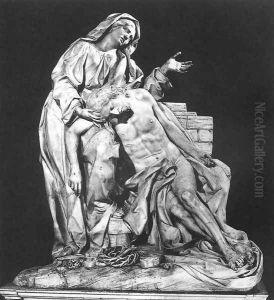Antonio Montauti Paintings
Antonio Montauti was an Italian sculptor of the Baroque period, born in 1683 in Florence, Italy. His work is lesser-known outside of connoisseur circles, but he made significant contributions to the artistic landscape of his time, especially in Florence and Rome. Montauti's early life and training are not thoroughly documented, but it is known that he was active in the early 18th century, a time when the Baroque style was flourishing in Italy. His style was marked by dynamic compositions, elaborate detail, and an emphasis on emotional expressiveness, typical of the Baroque movement.
Montauti's career saw him working on both religious and secular commissions. One of his most notable works is the allegorical figure of 'Charity' for the Corsini Chapel in the church of San Giovanni in Laterano in Rome, which showcases his skill in conveying complex emotional states and his adeptness in working with marble. His sculptures often depicted figures from mythology, religion, and history, imbued with a sense of movement and drama.
Aside from his work in marble, Montauti was also known for his smaller bronze sculptures, which were highly prized by collectors during his lifetime. These pieces exhibited the same attention to detail and emotional depth as his larger works but allowed him to explore more intimate themes and settings.
Despite his contributions to the art of sculpture, Montauti's name did not achieve the same lasting recognition as some of his contemporaries. After his death in 1743, his works were appreciated mainly by specialists and collectors, and only recently have efforts been made to study and celebrate his contributions to the Baroque movement. Today, Antonio Montauti's sculptures can be found in various museums and collections, appreciated for their technical mastery and emotional depth.
